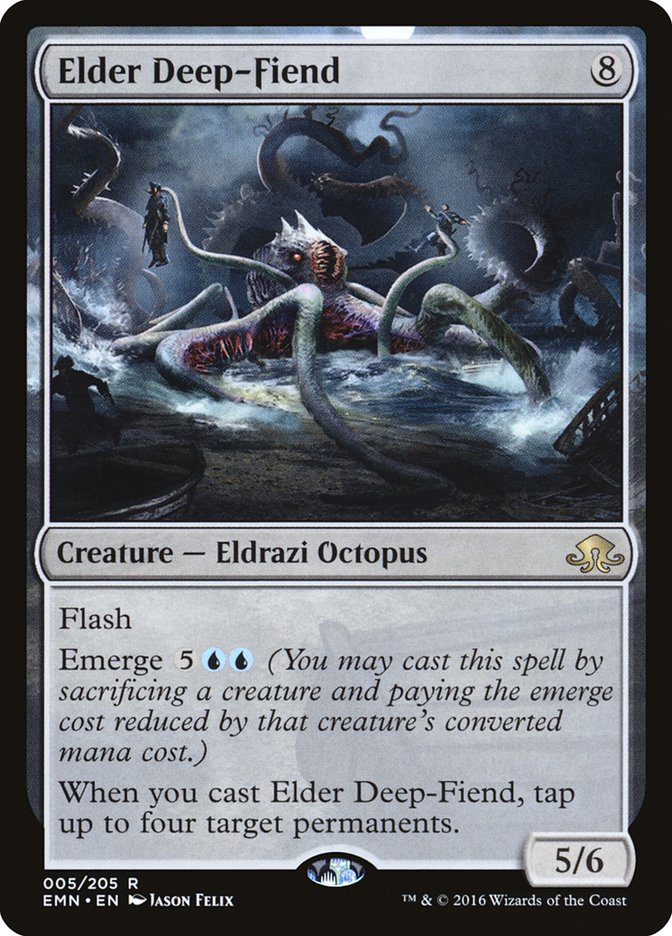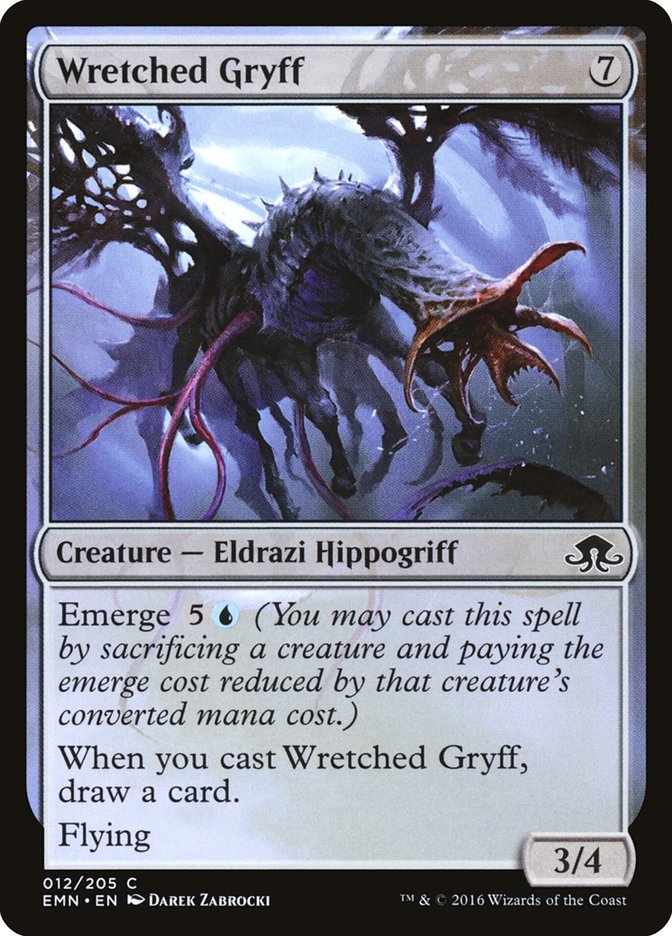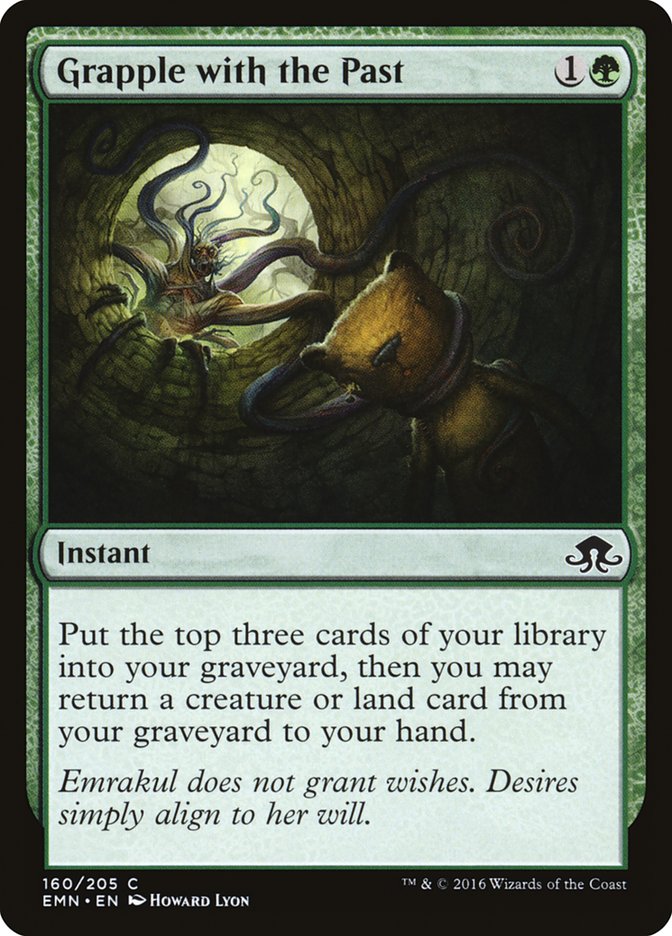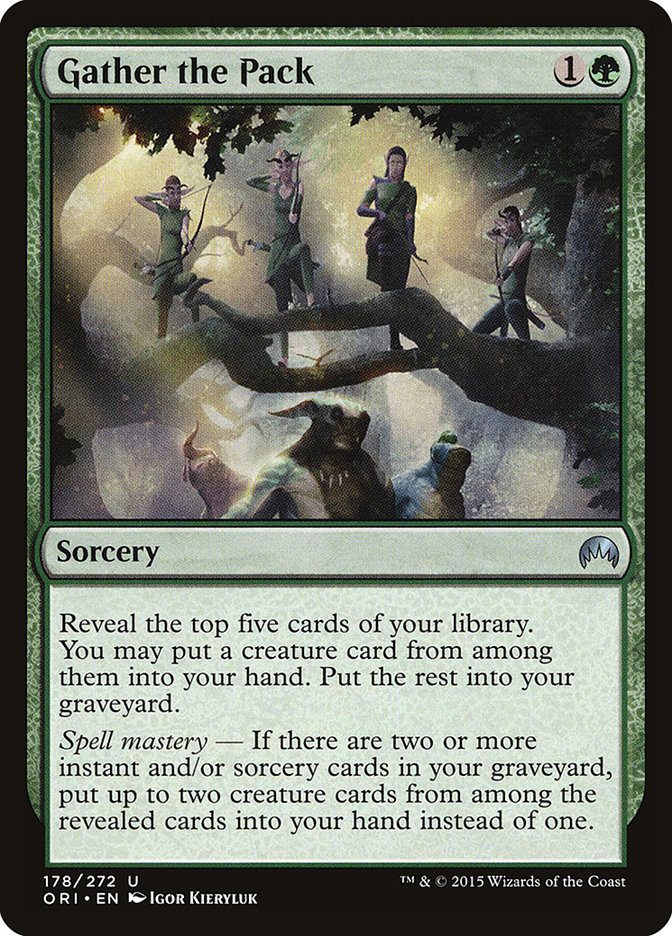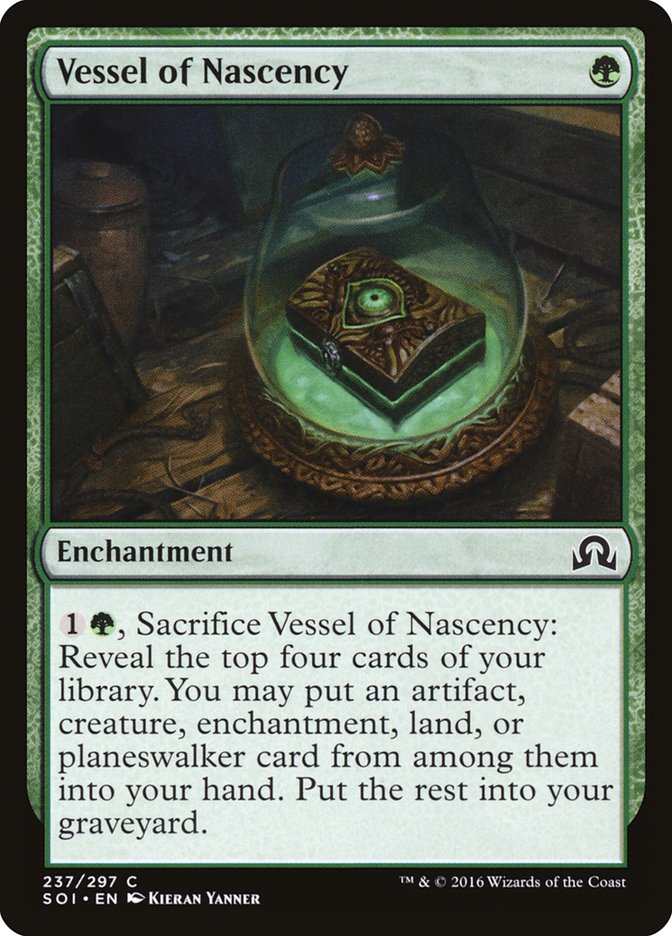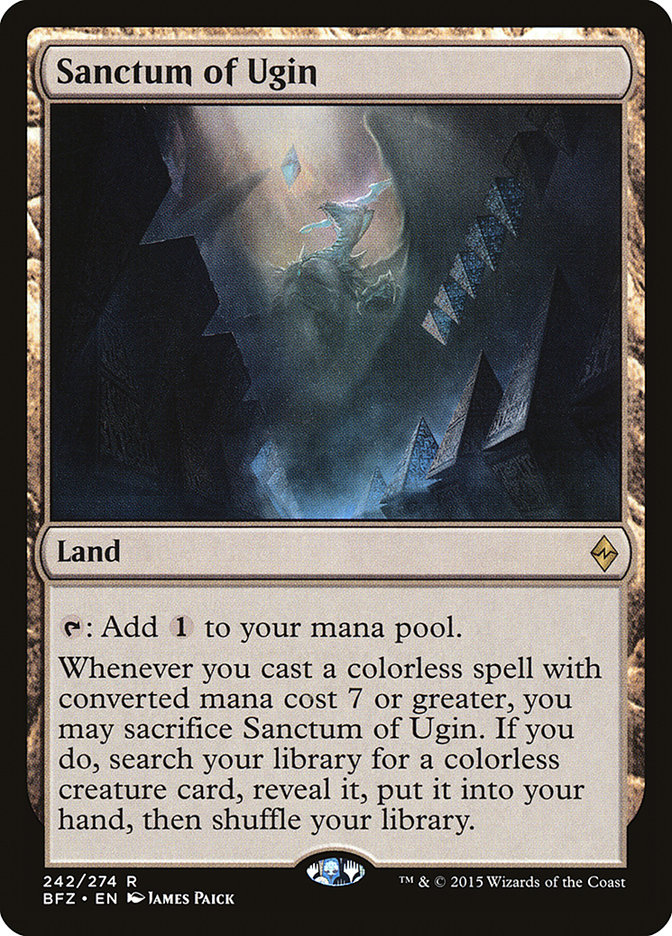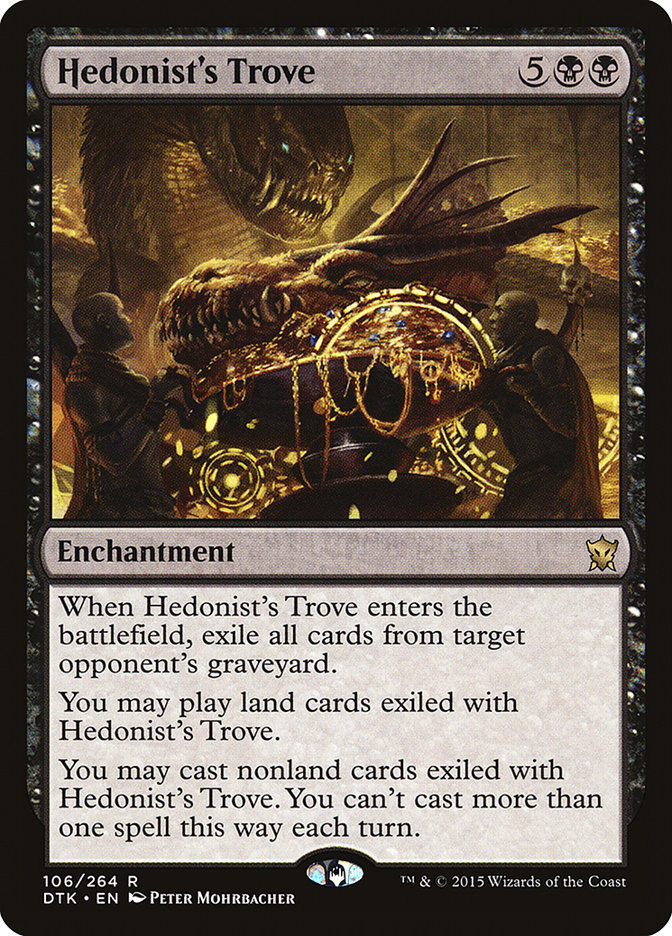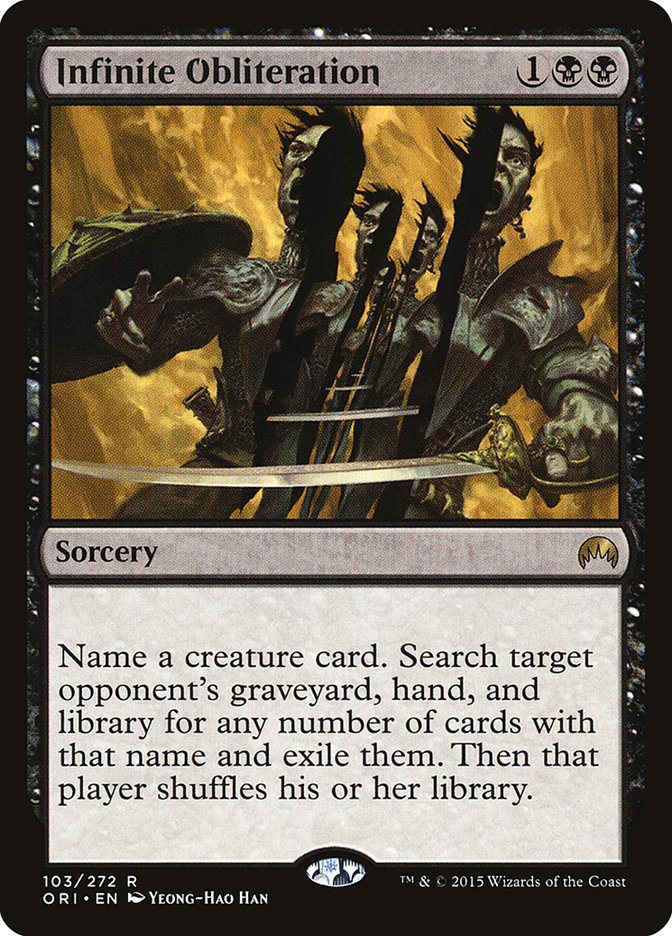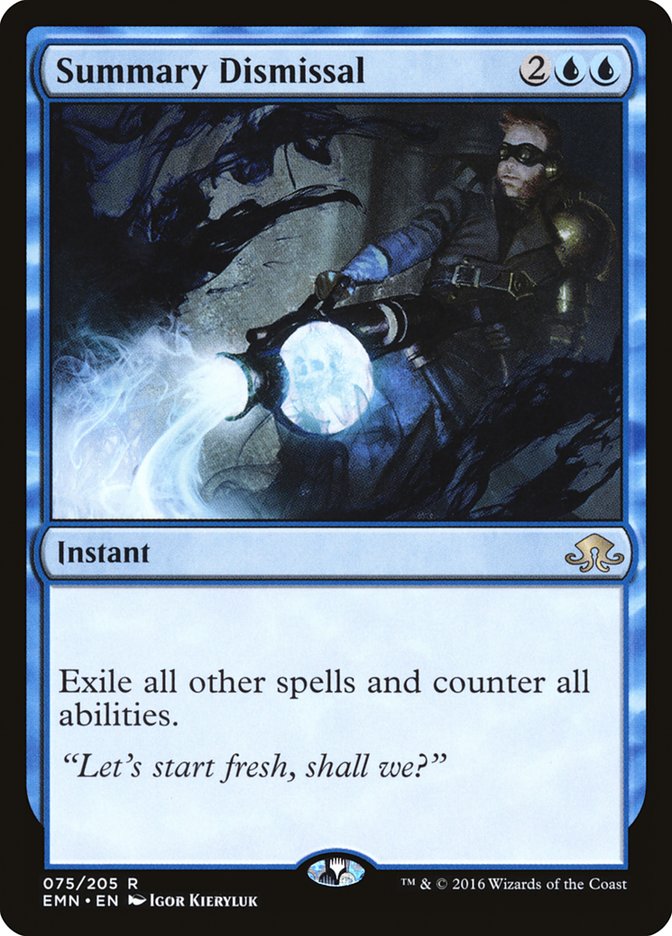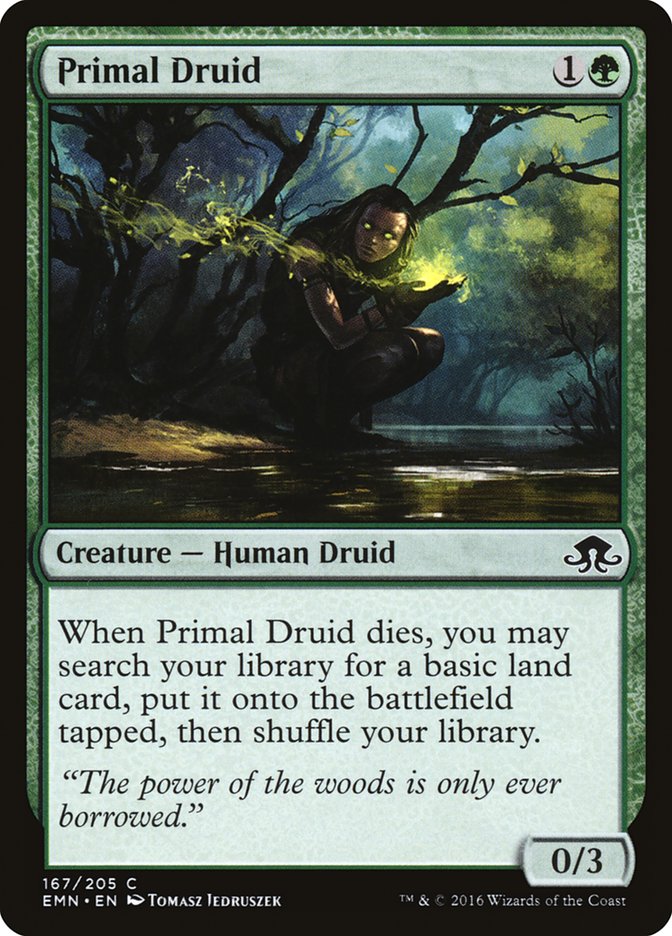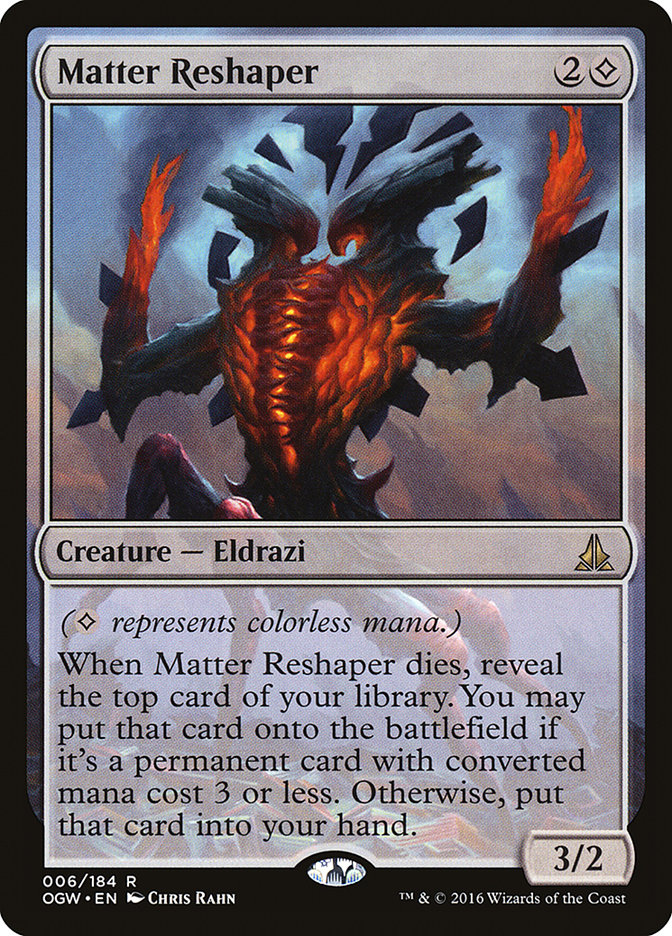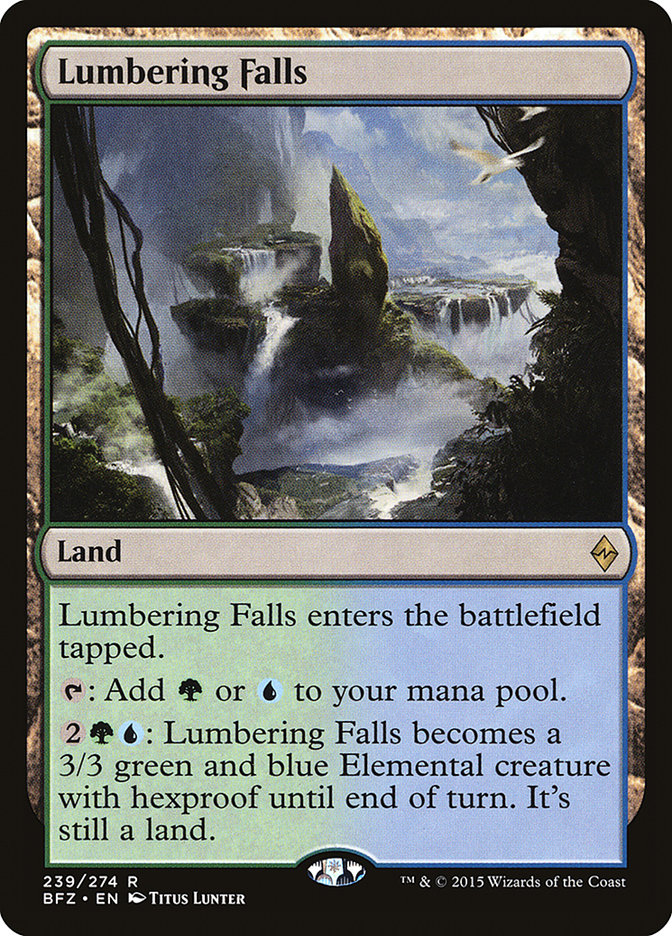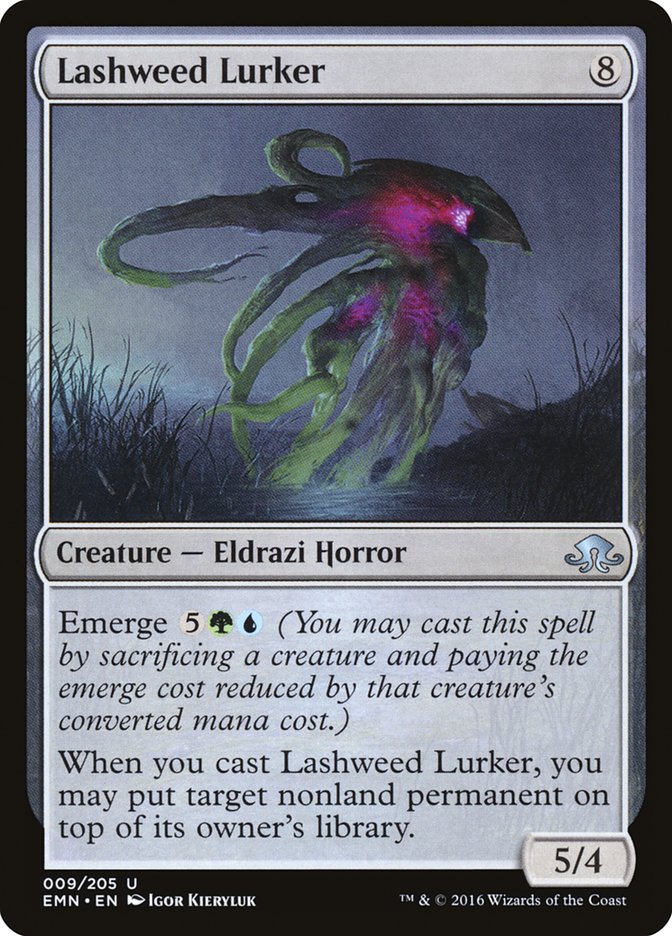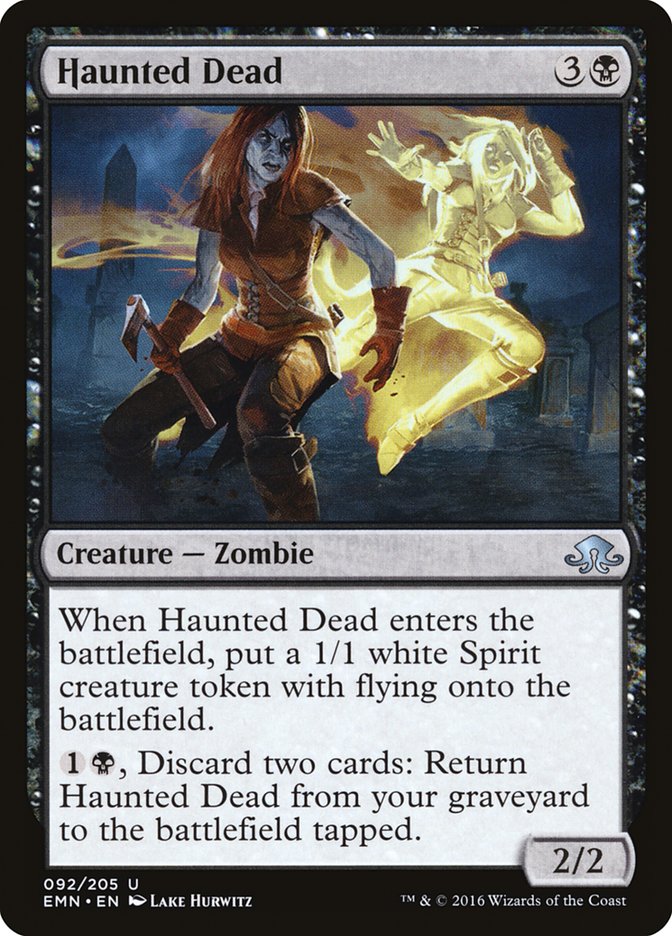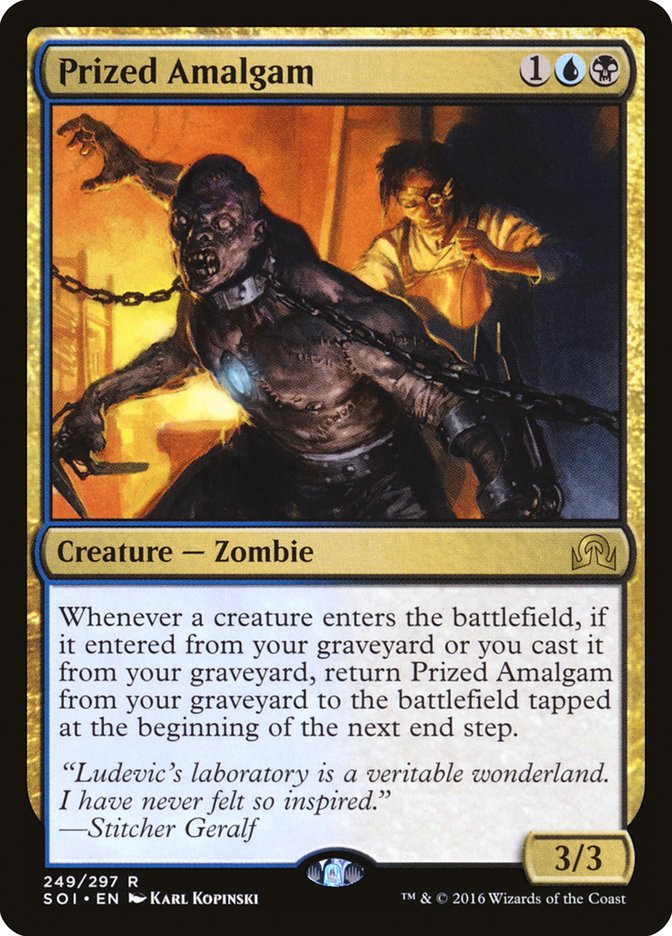This was going to be an article about all our awesome Standard brews. I might put it out later because all of them were really cool and actually close to reasonable in the Bant Company plus G/W metagame. But right now I can’t come close to endorsing any of them besides the deck I played.
My first look into Standard was reading about Replenish, Yawgmoth’s Bargain, and all the broken Urza’s Saga decks in a Scrye magazine. In the years since then I’ve played a lot of Standard and have seen some messed-up things occur. I’m not talking about metagame dominance like Cawblade, Jund, or Faeries. I’m talking about things that truly break the game of Magic. I stupidly opted to not play Skullclamp at multiple events because I thought I could beat it. I played FNMs with Sensei’s Divining Top, Counterbalance, Dark Confidant, and Umezawa’s Jitte. I played an Invitational where 15/60 cards in my maindeck are now banned in Modern.
Eldritch Moon Standard will now be a part of this list for the rest of my Magic career. The format is truly unfair, and it’s almost funny to look back a week at the hype over Bant Company. Why would I play that deck when I can just break all of the basic rules of Magic?
What Happened?
There is simply a confluence of traditionally broken effects in Eldritch Moon Standard, and all of them overlap into an interlocking mess of absurdity.
The big new issue is cost reduction, which is almost universally broken. Affinity and delve are great examples of this. Emerge is closer to echo as you have to invest something up front, but the effects you get are very strong for how early you get them. Similarly Emrakul, the Promised End has a high threshold to pass but is really, really powerful for the reduced cost.
This alone wouldn’t be broken. You are doing a decent amount of work to get your payoff, which isn’t that big.
Another issue is graveyard action that is free or reduced-cost. Stitchwing Skaab and Prized Amalgam have been making waves in older formats with the dredge mechanic, so they are clearly strong enough for Standard. Kozilek’s Return is also a very powerful effect that asks for a very specific thing and as a result has previously been homeless.
This alone wouldn’t be broken, but the interaction it has with the cost reduction is scary. Suddenly your seven-mana creature for Kozilek’s Return isn’t being cast on turn 7 but instead on turn 4 or 5 with the simple requirement of having a creature. When that creature is Haunted Dead, it costs three mana and your preemptive creature costs two and sometimes brings 3/3 Prized Amalgam friends.
The next layer of the issue looks pretty innocuous at first. We’ve had this style of self-mill effect for a long time in Standard and it hasn’t really produced anything broken. Sure, Satyr Wayfinder did a lot of work, and the trio of it, Grisly Salvage, and Commune with the Gods made a Nighthowler aggro deck that was decent, but nothing truly insane ever came of it until now.
Secretly, these cards have been a longstanding example of something that causes issues: cantrips with upside. None of them cost one mana, which is historically the requirement for brokenness, but we have entered a world where they produce much more than one mana of upside. Milling four random cards besides your creature with Gather the Pack is a quarter of a Kozilek’s Return found on top of your Impulse– or Anticipate-level card selection.
If just finding your graveyard payoff cards wasn’t enough of a bonus, you also have multiple ways to directly access the inactive cards in your graveyard once they get there. Grapple with the Past was advertised as a Corpse Churn / Seek the Wilds combo for Limited, but a better description would be an Anticipate / Regrowth split card with Kozilek’s Return upside. Meanwhile, there is Jace, Vryn’s Prodigy in the background, which enables graveyard shenanigans via looting, is drastically improved with aggressive self-mill, and suddenly gives you access to all these effects you are turning face-up over the course of a game. When one of those effects is Grapple with the Past, suddenly you just have access to every card you have seen over the course of the game at your fingertips.
Where things really go over the edge is when you add the multiple cheap or free tutors available to this strategy to the mix. Both Sanctum of Ugin and Traverse the Ulvenwald were clearly dangerous effects, but neither had really found a great home where they reached their full potential. The hoops were just too hard to jump through.
Suddenly everything just came together. You have graveyard-filling recursion powering your cost-reduced giant colorless creatures, and both of these powerful tutors can come online in the same shell. You even have a perfect thing to tutor for in Elder Deep-Fiend, which gets absolutely absurd in multiples.
The end result of all these moving pieces is a deck that for a low setup cost plays with full access to its deck and graveyard starting in the mid-game. In the process it generates tons of free value, often via massively game-changing free effects. Once it starts going, it literally kill all of its opponent’s nonland permanents, taps all their lands, and then takes their turns before killing them.
A key part of this is also the lack of good safety valves in the format for this kind of nonsense. There is basically no graveyard hate in the format. Your Tormod’s Crypt costs seven mana in Hedonist’s Trove, which is not happening when your lands are getting tapped on your upkeep. Infinite Obliteration is close, but it can’t name both Elder Deep-Fiend and Emrakul, the Promised End at the same time. Besides, you are playing against a deck with a ton of tutors. It’s super-easy to sideboard into a bunch of single creatures that all are game-breaking and the opponent can’t exile them all.
Or they can go super-deep and Coax from the Blind Eternities back anything you exile. There’s even a blunt answer to the answer.
The closest thing to a hate card is a four-mana counterspell. That’s it. It is certainly strong at times, but it has real limitations. Too much air like this and a random Matter Reshaper will beat you to death.
The Deck We Played
I’m not going to try and claim the Temur Emerge deck we (Team East-West Bowl) played was perfect. We didn’t fit all of the broken interactions into it, and even within what we had we are probably a card or two off. Still, I think that we were the closest to the full potential of this archetype.
Creatures (24)
- 3 Shaman of Forgotten Ways
- 4 Jace, Vryn's Prodigy
- 1 Nissa, Vastwood Seer
- 4 Matter Reshaper
- 4 Wretched Gryff
- 3 Elder Deep-Fiend
- 1 Lashweed Lurker
- 4 Primal Druid
Lands (24)
Spells (12)

What did we do that differed from the rest of the pack?
Primal Druid was the biggest improvement on our previous attempts at this shell. The 0/3 body made it hard for Bant to really run you over without overextending into Kozilek’s Return, and even though you get the land after emerging for the first time, the push towards hard-casting your Eldrazi is a big jump. Between lands found with Primal Druid, lands luckily found off Matter Reshaper, and Shaman of Forgotten Ways, you quickly get to cast Elder Deep-Fiend for full retail value even while sacrificing Sanctum of Ugin. The damage you deal per turn of looping lockdown effects starts increasing and your opponent quickly dies.
We also have a lot of incidental mediocre beatdown potential to increase the Elder Deep-Fiend clock. Once the “tap you down” loop is established, the game actually ends.
Also worth noting is that none of our enablers die to Liliana, the Last Hope’s -2/-1 ability. We had Foul Emissary for a long time and a Pilgrim’s Eye at times too, but every time they died it was horrible. The 1/1s also played very poorly against Bant, as taking a turn to cast something that doesn’t interact with them in combat early on is an easy way to just get run over.
Having access to more than four emerge creatures to trigger Kozilek’s Retun is also a big deal. Triggering an early Kozilek’s Return is the play that really shuts down the aggressive decks and you need to be able to make it happen. I’m unsure if you need seven or eight creatures here, but we started high and sideboarded down.
Some of the more linear lists cut Sanctum of Ugin, but that seems crazy to me. The chaining Elder Deep-Fiend draws are still some of the best things you can do, and simply making one emerge creature is not enough most of the time. Four might not be necessary, but this is really the thing you want to be doing and one of the draws to the deck. It also makes your sideboard colorless creatures that much more reliable. Thought Knot-Seer is one of the more common targets to curve out with after a Wretched Gryff in the mid-game.
I don’t think you actually need Emrakul, the Promised End in Game 1 against a lot of things. I also think a lot of the things you have to do to make it cost less than nine mana just make your deck worse, like the previously mentioned playing Pilgrim’s Eye.
What’s Next?
Wretched Gryff was key in getting off early Kozilek’s Returns, but in mirror matches and against control decks, having the fourth Elder Deep-Fiend over the fourth Wretched Gryff is much more important, not because you need the fourth Elder Deep-Fiend in chains (we cut it because it was excessive), but because you just want to draw the first one to get going.
I think we overemphasized the Traverse the Ulvenwald part of the sideboard. Maybe not in numbers, but in practice. The fourth Traverse the Ulvenwald rarely came in, and I think it is possible that the second and third should be used sparingly as well. The only times you really want them are when you want early red mana for Radiant Flames or want Ishkanah, Grafwidow to clog the battlefield, which are conveniently the same situations. If Humans and Spirits are completely gone from the metagame, I could see opening up a couple of sideboard slots here.
The biggest thing is I don’t think we tried hard enough to really break it. Our early-game still was entirely fair and the broken stuff didn’t start happening until turn 4. I think you can make a build of this deck that hybridizes the best aspects of all the broken things and has the potential for really broken draws. While there are a lot of mana and card count constraints to balance, I think we can dream bigger. This is where I would start if I was playing Standard next weekend at the Classic at #SCGNY or at #GPPortland.
Creatures (23)
- 4 Jace, Vryn's Prodigy
- 2 Matter Reshaper
- 4 Prized Amalgam
- 2 Wretched Gryff
- 4 Elder Deep-Fiend
- 4 Haunted Dead
- 3 Primal Druid
Lands (24)
Spells (13)

While some groups had the Prized Amalgam engine with their Elder Deep-Fiends, I don’t think there was anyone doing all the things I want to do at once. I want Primal Druids for more mana, the graveyard creatures for cascading battlefield states, extra emerge creatures to ensure Kozilek’s Returns, and some access to the Traverse the Ulvenwald and Sanctum of Ugin engines for the full chain. I also want a Vessel of Nascency to make my sideboard Emrakul, the Promised End better and because multiple Gather the Pack early leads to missed land drops at times.
I will make one disclaimer about all of these decks: Often it is hard to tell in testing if you have things right or not because they are so hard to play. There are many small sequencing decisions because your low-end spells are modular. You constantly are choosing between anything possible from your entire deck and graveyard. Choosing when you move on Elder Deep-Fiend to stop their key turn or when you are getting enough value out of Kozilek’s Return or when you just go to beatdown mode is all tricky.
Still, this archetype is doing things that simply shouldn’t happen in Standard. While the final tables of the Pro Tour didn’t quite break its way, I expect in a few months that we will be remembering this as something truly special.


